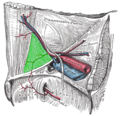Inguinal Hernia
Making up 75% of all abdominal-wall hernias and occurring up to 25 times more often in men that women. These hernias are divided into two different types, direct and indirect. Both occur in the groin area, but they have slightly different origins. Both of these types of hernias can similarly appear as a bulge in the inguinal area. The two types of inguinal hernia, direct and indirect, are defined by their relationship to the inferior epigastric vessels.
Direct Inguinal Hernia[edit | edit source]
Direct inguinal hernias occur medial to the inferior epigastric vessels when abdominal contents herniate through a weak spot in the fascia of the posterior wall of the inguinal canal, which is formed by the transversalis fascia. the direct inguinal hernia occurs slightly to the inside of the site of the indirect hernia, in an area where the abdominal wall is naturally slightly thinner. Unlike the indirect hernia , which can occur at any age, the direct hernia tends to occur in the middle-aged and elderly because their abdominal walls weaken as they age.
The inguinal triangle is a region of the abdominal wall. It is defined by the following structures: Lateral margin of the rectus abdominal sheath, Inferior epigastric vessels and inguinal ligament. The inguinal triangle contains a depression referred to as the medial inguinal fossa, through which direct inguinal hernias protrude through the abdominal wall.
Indirect Inguinal Hernia[edit | edit source]
Indirect inguinal hernias occur when abdominal contents protrude through the deep inguinal ring, lateral to the inferior epigastric vessels;this may be caused by failure of embryonic closure of the processus vaginalis.
In the case of the female, the opening of the superficial inguinal ring is smaller than of the male. As a result, the possibility for hernias through the inguinal canal in males is much greater because they have a larger opening and therefore a much weaker wall for the intestines to protrude through. An indirect hernia follows the pathway that the testicles made during fetal development, descending from the abdomen into scrotum. This pathway normally closes before birth but may remain a possible site for a hernia in later life. Sometimes the hernia sac may protrude into the scrotum. An indirect inguinal hernia may occur at any age.
Links[edit | edit source]
Related Articles[edit | edit source]
Bibliography[edit | edit source]
NETTER, Frank. Atlas of human anatomy. 5th edition. 2011. ISBN 978-1-4160-5951-6.
MOORE, Keith. Clinically oriented anatomy. 6th edition. 2010. ISBN 978-1-60547-652-0.


